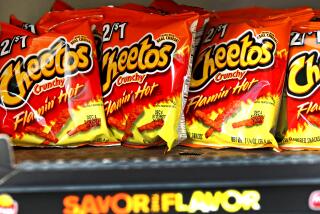With kids, it’s all in the wrapper
Children develop lifelong food preferences at a very young age -- before they can distinguish between ads and facts. Now a study has added to the controversy about advertising to them, with child psychologists saying the findings support the need for government restrictions on ads targeted at children.
In the study, children ages 3 to 5 preferred burgers, fries, chicken nuggets, milk or carrots with a McDonald’s label to identical food in plain white wrappers. The likelihood that they preferred the labeled foods increased with the number of TV sets in the home, as well as with the frequency of visits to McDonald’s.
Past research had looked at the effect of advertising alone on children’s behavior. But this study, published in the August issue of the journal Archives of Pediatrics & Adolescent Medicine, was the first to look at how familiarity with the brand, through McDonald’s toys in their homes or family dinners out, also influenced their food preferences. In developing food preferences, children combine the actual experience of a restaurant or the taste of a food with information picked up from ads; the sensations reinforce each other. Of the 63 children studied, only two had never been to a McDonald’s.
Psychologists say children younger than 7 or 8 can’t perceive the persuasive intent of advertisements. The new study, communications experts say, drives that point home.
“Small children will process the advertisement’s information in the same way the average American would a news story on CNN -- they tend to accept it at face value,” says Dale Kunkel, a communications professor at the University of Arizona.
The findings come amid growing concern about advertisers’ influence on children.
In July, 11 food and beverage companies promised to stop advertising candy bars, soda and sugary cereals on kids’ TV shows. Since the Institute of Medicine released a report in 2004 detailing the influence of food marketing on children, legislators have been studying the connection between the media and childhood obesity. And the American Psychological Assn. has recommended a total ban on advertising to children younger than 8.
Susan Linn, the director of Harvard’s Judge Baker Children’s Center, called the study “very elegant,” saying it demonstrates that “branding works even on very, very young children . . . and actually trumps sensory input.”
Linn says the U.S. regulates advertising to kids less than most industrialized countries. Since 1991, Sweden has banned advertising to kids younger than 12, and this April the United Kingdom passed a similar ban for kids ages 4 to 9, with the minimum allowable age set to increase to 16 in 2009.
The study’s authors suggest that food marketers’ enormous influence be used to promote more nutritious food.
Commenting on the study, Joanne Cantor, director of the Center for Communication Research at the University of Wisconsin-Madison, says typical public-service announcements about healthful eating fail because they lack the punch of enormous advertising campaigns promoting less nutritious fare. She says she’s not surprised by the findings. When PSAs and fast-food ads work at cross-purposes, she says, “it’s just David and Goliath.”
“The only way you’re gonna get a big successful commercial campaign is from a big company. What if Ronald McDonald introduced kids to broccoli. . . . “
Some scientists are skeptical about whether fast-food outlets will ever give equal ad time to healthful foods. “People can’t make money off a banana, because a banana is a banana,” Cantor says.
But the study, conducted by researchers at Stanford University and Lucile Packard Children’s Hospital, showed that the positive effect of the McDonald’s label is transferable to healthful snacks such as carrots, even without ads specifically featuring them. Carrots wrapped in McDonald’s packaging tasted better to the children surveyed than did carrots in a plain wrapper. (No such ads exist because McDonald’s doesn’t sell carrots). Kunkel says that because McDonald’s ads emphasize the “fun and happiness” provided by the brand, children are inclined to like anything sporting the name.
Kunkel says the makeup of fast-food menus and ads are “a media issue, a public issue, an agriculture issue.” In 2007, it costs more to eat healthfully than to eat junk food. But he says that if vendors say they can’t provide cheap healthful food, it’s disingenuous. “They just have to apply their ingenuity in new and creative ways to find healthy foods that can be delivered economically.
“A lot of fast-food outlets have begun to introduce healthier foods -- but it’s very apparent they’re not promoting them actively. Once they do, we’ll see the movement we hoped for.”
Kunkel says exposure alone doesn’t teach consumers skepticism -- kids first have to reach a certain level of cognitive development. “Media training absolutely has value for older children . . . for younger children it’s not relevant,” he says.






